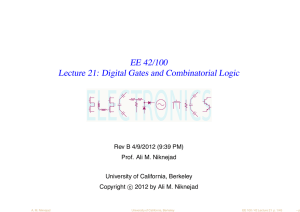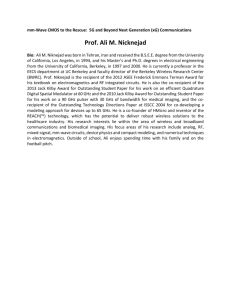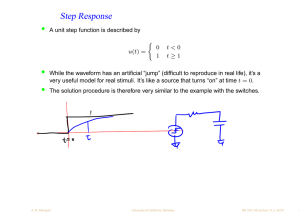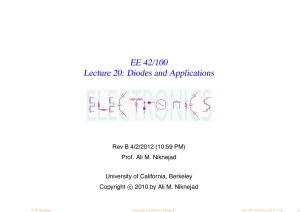ELECTRONICS EE 42/100 Lecture 21: Digital Gates and Combinatorial Logic
advertisement
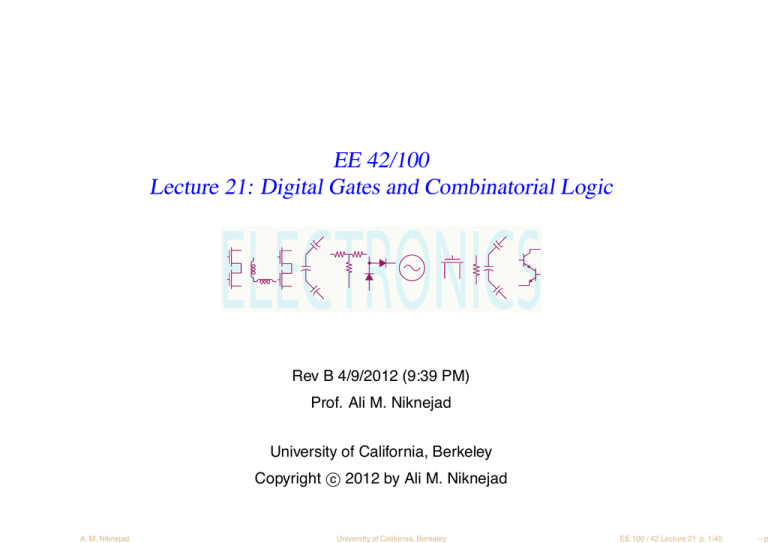
EE 42/100
Lecture 21: Digital Gates and Combinatorial Logic
ELECTRONICS
Rev B 4/9/2012 (9:39 PM)
Prof. Ali M. Niknejad
University of California, Berkeley
c 2012 by Ali M. Niknejad
Copyright !
A. M. Niknejad
University of California, Berkeley
EE 100 / 42 Lecture 21 p. 1/45
–p
Digital versus Analog
•
Real signals are continuous (at least we perceive them that way) whereas binary
signals can only take on two values.
•
For instance the current temperature in this room is a certain number of degrees
and the resolution of this number is in principle infinite (noise limited).
•
But for many applications, the precise value is not important. A finite
representation (certain number of significant figures) is all that we need. We may
therefore sample the signal periodically (not continuously) and also round off the
actual amplitude of the signal. Note that we are making two approximations: the
discrete time sampling of the signal and the discretization process.
•
Intuitively, as long as we sample the signal faster than the rate at which it changes
(can be made precise using Nyquist’s Sampling Theorem), then no information is
lost.
A. M. Niknejad
University of California, Berkeley
EE 100 / 42 Lecture 21 p. 2/45
–p
Quantization Noise
•
On the other hand, the quantization of the signal introduces round-off errors in our
signal. If we subtract out the ideal signal s(t) from the quantized signal ŝ(t), the
difference is the error signal, which varies randomly from sample to sample.
n(t) = s(t) − ŝ(t)
•
We can therefore think of the process as introducing “quantization noise” in the
signal.
ŝ(t) = s(t) − n(t)
•
In other words, if we are insensitive to changes of the signal smaller than the
quantization noise, then the approximation is okay.
A. M. Niknejad
University of California, Berkeley
EE 100 / 42 Lecture 21 p. 3/45
–p
Analog-to-Digital Converter
•
The important specifications for an ADC are the sampling rate (clock rate) of the
ADC and its resolution (number of bits).
•
Analog signals need to be sampled at a rate of twice the signal bandwidth (audio
bandwidth is roughly 5 kHz).
•
The resolution determines the smallest discernible signal since the full-scale input
voltage (say 5V) is divided by 2N where N is the number of bits. Any signal
smaller than this level is lost in the “quantization noise” (round-off error).
A. M. Niknejad
University of California, Berkeley
EE 100 / 42 Lecture 21 p. 4/45
–p
Binary Numbers
•
Binary numbers can only take on two values {0, 1}. To specify a bigger number,
you have to use more digits. For instance:
1010b = (1)23 + (0)22 + (1)21 + 0(20 ) = 8 + 2 = 10
•
Some aliens with only two fingers may naturally use binary numbers but we use
them because our computers can only store two states (note: digit means finger).
•
To convert a decimal number into binary, you can repeatedly divide by 2 and take
the remainder as the next digit.
•
Example: 50 in binary is:
50/2 = 25r0, 25/2 = 12r1, 12/2 = 6r0, 6/2 = 3r0, 3/2 = 1, r1, 1/2 = 0r1. This
implies the number is given by 110010b (read it backwards). Verify that
24 + 21 = 8 + 4 = 12. Or
32 + 16 + 2 = 25 + 24 + 21 = 110010b
A. M. Niknejad
University of California, Berkeley
EE 100 / 42 Lecture 21 p. 5/45
–p
Binary Signals
•
Binary signals are designed to only take on two values, say {0V, 5V } to represent
{0, 1} (positive or negative logic possible).
•
As signals propagate in wires, inevitably noise, distortion, and cross-talk occurs,
which corrupts the signal. An analog signal is corrupted directly whereas a digital
signal is only corrupted if the noise exceeds the noise margin of the circuit.
•
Digital signals are therefore more robust and can be easily regenerated whereas
analog signals get more noisy as we process them.
A. M. Niknejad
University of California, Berkeley
EE 100 / 42 Lecture 21 p. 6/45
–p
Hexadecimal
•
A long string of binary numbers if hard to read. We therefore group 4 bits into a
nibble and group eight bits into a byte (early CS people had a good sense of
humor!).
•
A nibble can take on 16 different distinct values, so a base 16 number system is
used to describe it: {0, 1, 2, · · · , A, B, C, D, E, F }. Note that we use letters to
represent numbers. This takes some getting used to!
•
A byte is described by two hexadecimal digitals. For instance, we converted 50 in
binary as 110010b . Let’s extend it to 8 bits by zero padding, 00110010b , or two
nibbles of 0011 and 0010, which in hex are 3hex and 2hex , which we write as
32hex . Verify
32hex = 3 · 161 + 2 · 160 = 48 + 2 = 50
A. M. Niknejad
University of California, Berkeley
EE 100 / 42 Lecture 21 p. 7/45
–p
Binary Arithmetic
•
Binary arithmetic is exactly the same as what you learned in grade school, except
there are only two digits! For adding single bits
0+0=0
1+0=0+1=1
1 + 1 = 0 + carry
•
Let’s add two nibbles
0101
+0011
——1000
A. M. Niknejad
(5)
(3)
(8)
University of California, Berkeley
EE 100 / 42 Lecture 21 p. 8/45
–p
Signed Binary and Two’s Complement
•
To represent negative numbers, we could add a “sign bit” in front of the number but
it turns out that addition no longer works (between positive and negative numbers).
A more elegant system that preserves addition (and hence supports subtraction) is
the two’s complement system.
•
In the two’s complement system, the first half of the 2N numbers are assigned to
zero and the positive integers and the second half is used for the negative
integers. Because addition is modulo 2N (wraps around after 2N ), when you add
a number m and it’s negative counterpart, it should sum up to wrap back to zero,
which would happen if m were equal to 2N − m.
•
Take the number 0001. It’s 2’s complement is 24 − 1 = 15 or 1111. If we add these
two numbers in binary, we get
0001
+1111
10000
If we only preserve 4 bits of the result, then we’re back to zero.
•
Another way to calculate the 2’s complement: Invert all the bits and add 1. So for 1
we have 0001 → 1110 → 1111, which is the same as above.
A. M. Niknejad
University of California, Berkeley
EE 100 / 42 Lecture 21 p. 9/45
–p
Two’s Complement Example
•
Example: Add 5 + (−4). 5 = 0101 and −4 is formed by first forming 4, 4 = 0100,
inverting, 1011, and then adding 1, 0001 + 1011 = 1100. Now if we add
5 + (−4) = 0101 + 1100 = 0001, which shows that everything works!
•
Note that the most significant bit is still 1 for all negative numbers, which is also a
kind of sign bit.
A. M. Niknejad
University of California, Berkeley
EE 100 / 42 Lecture 21 p. 10/45
–
What’s a logic gate?
•
First let’s consider the Digital Abstraction in which we build circuits where the
inputs and outputs are only interpreted as “high” or “low”. Since the circuit only
operates on two inputs, it’s a binary circuit. In the binary circuit, the two inputs are
binary digits “0” and “1”.
•
A logic gate performs a logic function. It has several inputs and it produces an
output. The inputs and outputs can only take on values of {0,1}.
•
•
By convention, all the inputs are put on the left and the output(s) are on the right
The function is completely described by a truth table
A. M. Niknejad
University of California, Berkeley
EE 100 / 42 Lecture 21 p. 11/45
–
AND, OR, and XOR
•
The AND function is very common. The output is 1 only if both inputs are one. We
write this relation as a product
y = AB
•
The OR function produces a 1 as long as one input is 1. We write this relation as
y =A+B
•
Exclusive OR, or XOR, only produce a one if one of its inputs is 1. If both are 1 or
0, the output is 0. This is written as
y =A⊕B
A. M. Niknejad
University of California, Berkeley
EE 100 / 42 Lecture 21 p. 12/45
–
NOT Gate
•
The NOT gate inverts its input and it’s not surprising that it’s also known as an
inverter. As we’ll see, this is a very crucial function. The notation for NOT is
y = A!
y =∼ A
y =!A
y=A
•
Notice that the OR operation is the same as the AND operation if we NOT its
inputs.
A. M. Niknejad
University of California, Berkeley
EE 100 / 42 Lecture 21 p. 13/45
–
Buffer is more than a wire
•
•
A buffer has the same output as its input. It seems rather trivial!
From the perspective of logic, the buffer is the same as a wire, but in a real
electrical circuit, a buffer is an amplifier that can be used to reduce the capacitive
loading of a stage and help drive large capacitance. Thinks of the voltage follower.
A. M. Niknejad
University of California, Berkeley
EE 100 / 42 Lecture 21 p. 14/45
–
NAND and NOR
•
The NAND and NOR gates are the same as AND and OR except the outputs are
inverted. In real circuit implementation, they are often easier to realize than AND
and OR.
A. M. Niknejad
University of California, Berkeley
EE 100 / 42 Lecture 21 p. 15/45
–
Multi Input Logic
•
So far we have only dealt with two input logic gates. The concept generalizes to
any number of inputs and outputs.
•
Multi-input logic gates can be synthesized from two-input gates.
A. M. Niknejad
University of California, Berkeley
EE 100 / 42 Lecture 21 p. 16/45
–
Combinatorial versus Sequential
•
The kinds of gates that we have been describing can be interconnected to build a
combinatorial logic circuit. This is as opposed to a “sequential” logic circuit. The
difference is that a combinatorial logic circuit is only a function of the current
inputs. In other words, it has no memory. A sequential logic circuit, on the other
hand, has memory and so the current output is a function of the current input and
past inputs/outputs.
A. M. Niknejad
University of California, Berkeley
EE 100 / 42 Lecture 21 p. 17/45
–
Boolean Equations
•
The algebra of binary digits is known as Boolean algebra. It’s very simple because
there are only two possible inputs. Typical expressions are of the following form:
y = AB C
•
When an expression is a product of all of it’s inputs, it’s known as a minterm. When
a term is a sum of all of it’s inputs, it’s called a maxterm.
A. M. Niknejad
University of California, Berkeley
EE 100 / 42 Lecture 21 p. 18/45
–
Order of Precedence
•
How do you interpret an expression such as y = A + BC ?
?
?
y = A + BC = (A OR B) AN D C = A OR (B AN D C)
•
The rules of precedence determine the order of evaluation. The NOT operator has
the highest precedence, followed by AND, and then OR.
A. M. Niknejad
University of California, Berkeley
EE 100 / 42 Lecture 21 p. 19/45
–
Sum of Products Form
•
Any function can be written in a sum of products form. Simply examine the truth
table and for each ‘1’ output, write the corresponding minterm:
y = A B C + ABC + ABC
A. M. Niknejad
University of California, Berkeley
EE 100 / 42 Lecture 21 p. 20/45
–
Product of Sums
•
Any function can also be written in the product of sums form. Simply examine the
truth table and for each ‘0’ input, write the corresponding maxterm:
y = (A + B + C)(A + B + C)(A + B + C)(A + B + C)
•
When is the product of sums form better? When it produces a shorter expression.
This happens of course when there are fewer zeros than ones in the truth table
output.
A. M. Niknejad
University of California, Berkeley
EE 100 / 42 Lecture 21 p. 21/45
–
Boolean Algebra Axioms
A1
A2
A3
A4
A5
•
B = 0 if B &= 1
0=1
0·0=0
1·1=1
0·1=1·0=0
A1’
A2’
A3’
A4’
A5’
B = 1 if B &= 0
1=0
1+1=1
0+0=0
1+0=0+1=1
By definition, axioms cannot be proven. We use them as self-consistent definitions
that can be used as givens when deriving theorems.
A. M. Niknejad
University of California, Berkeley
EE 100 / 42 Lecture 21 p. 22/45
–
Boolean Algebra Theorems
T1
T2
T3
B·1=B
B·0=0
B·B =B
T1’
T2’
T3’
B+0=B
B+1=1
B+B =B
T4
T5
B=B
B·B =0
T4’
T5’
B=B
B+B =1
•
Theorems can be proven from Axioms. Most of these are pretty obvious but you
can also always check by putting in all possible inputs and verifying that both sides
are equal.
•
These theorems are very useful for simplifying results.
A. M. Niknejad
University of California, Berkeley
EE 100 / 42 Lecture 21 p. 23/45
–
More Theorems
T6
T6’
T7
T7’
T8
T8’
T9
T9’
T10
T10’
T11
T11’
T12
T12’
B·C =C·B
B+C =C+B
(B · C) · D = B · (C · D)
(B + C) + D = B + (C + D)
(B · C) + (B · D) = B · (C + D)
(B + C) · (B + D) = B + (C · D)
B · (B + C) = B
B + (B · C) = B
(B · C) + (B · C) = B
(B + C) · (B + C) = B
(B · C) + (B · D) + (C · D) = B · C + B · D
(B + C) · (B + D) · (C + D) = (B + C) · (B + D)
B0 · B1 · B2 . . . = (B0 + B1 + B2 + · · · )
B0 + B1 + B2 + · · · = (B0 · B1 · B2 · · · )
Commutativity
Associativity
Distributivity
Covering
Combining
Consensus
De Morgan’s Theorem
•
The theorems are the usual things we’re familiar with from algebra, including
commutativity, associativity, and distributivity. There’s also covering, combining,
and consensus, which are new.
•
De Morgan’s Theorem is extremely useful and should be studied carefully.
A. M. Niknejad
University of California, Berkeley
EE 100 / 42 Lecture 21 p. 24/45
–
Equation Minimization
•
Using the Axioms and Theorems of Boolean Algebra, we can simplify expressions.
For example
y = A B C + AB C + ABC
•
Can be simplified using distribution in the first two terms
y = B C(A + A) + ABC
•
But A + A = 1 and anything times 1 is itself
y = B C(1) + ABC = B C + ABC
•
Can we do better? Notice the simplification resulted because the first two terms
only differed by 1 bit, A. But the last two terms also differ in only 1 bit, C. We could
have combined these two terms as well, giving us the same complexity in the
minimized term.
•
But we can also be clever and duplicate the middle term! That’s because
A + A = A. Show that we then can get down to
y = B C + AB
A. M. Niknejad
University of California, Berkeley
EE 100 / 42 Lecture 21 p. 25/45
–
From Logic to Gates
•
It’s now very easy to see how we can synthesize any Boolean expression using
logic gates. For instance, to realize an expression in sum of products terms, we
first form the miterms using AND gates and then we OR the outputs.
A. M. Niknejad
University of California, Berkeley
EE 100 / 42 Lecture 21 p. 26/45
–
Other Possible Ouputs
•
When an illegal output occurs in a logic gate, we denote that as ‘X’. Suppose we
have a circuit where there is a contention between two logic gates. The output will
then be an illegal output (not a well defined ‘0’ or ‘1’) and the circuit may not
function correctly or as expected.
•
The same notation is used for a “don’t care” output, in other words if we don’t care
about a particular output, so be careful.
•
Many logic gates have an “enable” input that can put the output into a third state,
known as a floating or high impedance (high-‘Z’) state. This is known as a ‘Z’ state
for this reason.
•
A common block with this functionality is a tristate buffer. This is very useful in
busses and other circuits where multiple gates drive the same output. Now a
contention is not longer present as long as only one gate is enabled.
A. M. Niknejad
University of California, Berkeley
EE 100 / 42 Lecture 21 p. 27/45
–
MUX
•
A MUX or multiplexer simply selects one of its inputs based on the “select” input.
You can think of it as a three input logic gate with the truth table shown below.
•
A MUX can be implemented using a two-level logic, or using tri-state buffers.
A. M. Niknejad
University of California, Berkeley
EE 100 / 42 Lecture 21 p. 28/45
–
4:1 MUX
•
•
Higher order MUX circuits are also handy and can be realized in different ways.
Notice that any truth table with 2 inputs can be realized by connecting the inputs of
the 4:1 MUX to either supply or gnd !
A. M. Niknejad
University of California, Berkeley
EE 100 / 42 Lecture 21 p. 29/45
–
Decoders
•
A decoder is very handy when building a memory. There are N inputs and 2N
outputs. Only one output is selected at a time.
A. M. Niknejad
University of California, Berkeley
EE 100 / 42 Lecture 21 p. 30/45
–
